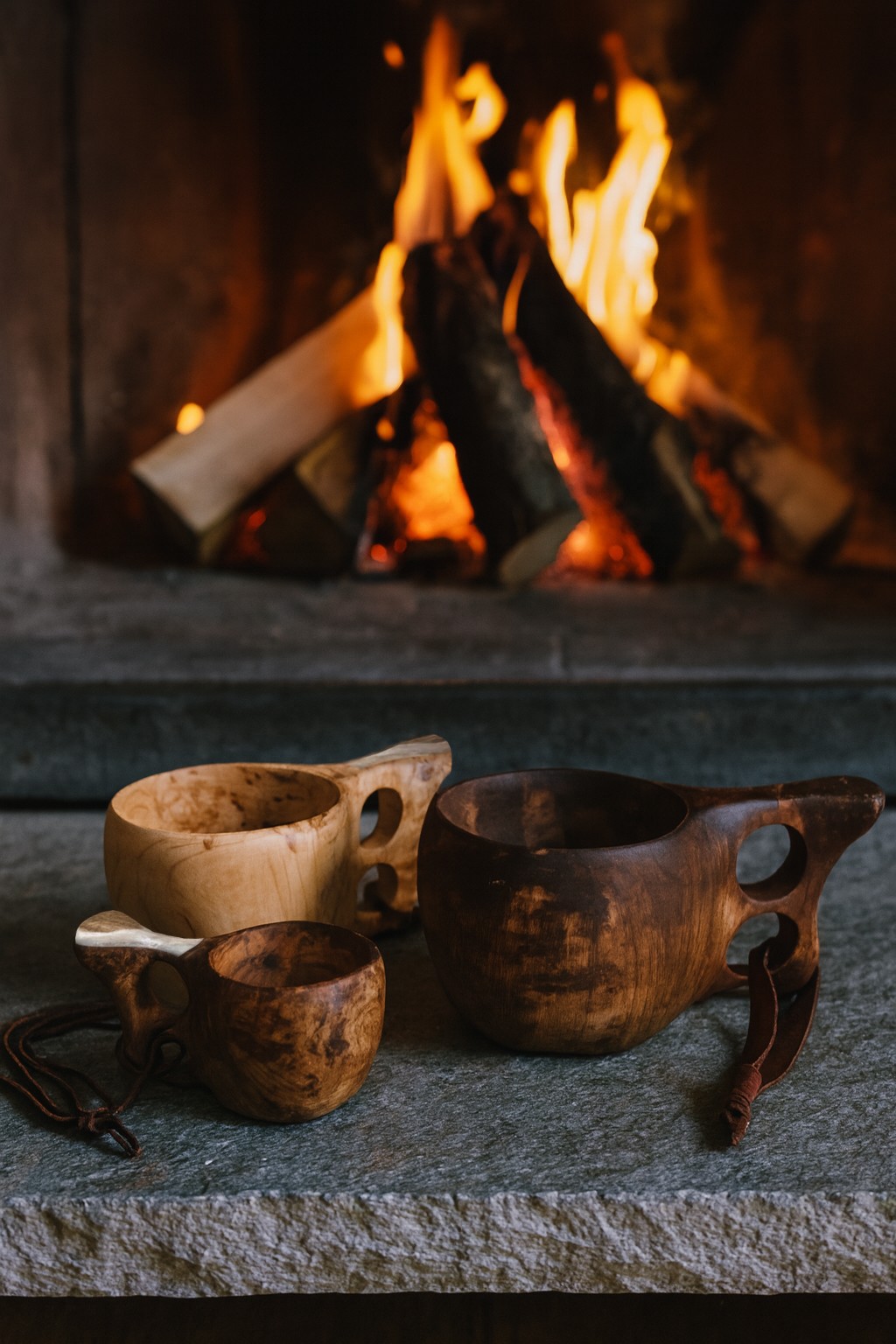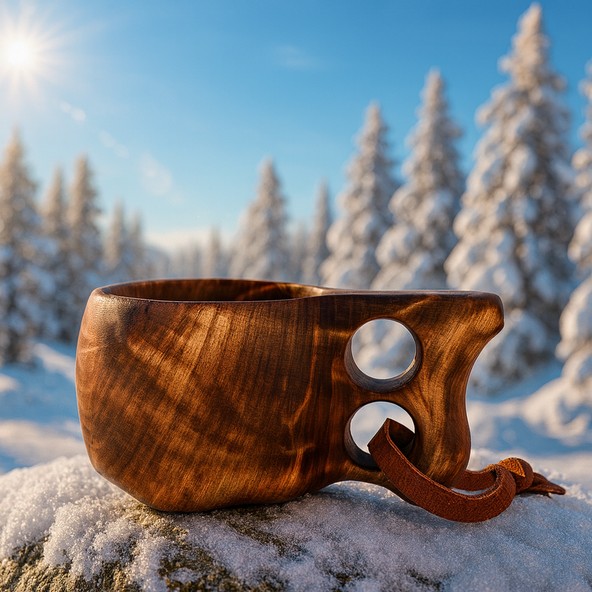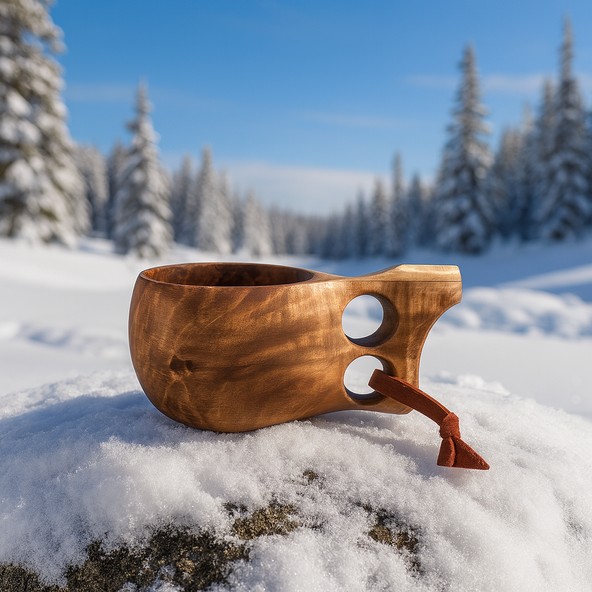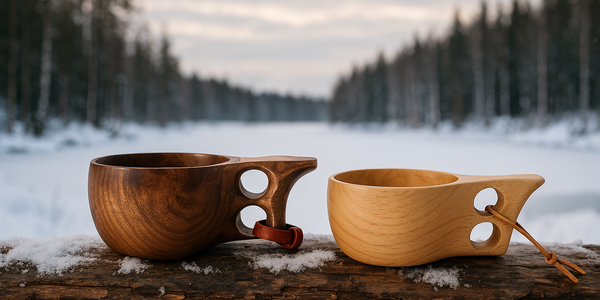A handmade Christmas elf is gifted with every order 🎄🎁 A handmade Christmas elf is gifted with every order 🎄🎁
What are the origins of kuksa?
Have you heard of kuksa? Do you own one? Are you thinking of making your own? Before all that, let’s start by explaining the origins of kuksa and why it is important to preserve this Scandinavian tradition.

Anne-Laure Compain
How did the kuksa originate?
Originally, kuksa were used by the Sami as a personal container. They could be used for drinking, eating, and even for berry picking. This multifunctional cup therefore had to be durable and sturdy to meet all of its owner's needs.
Kuksa are part of Duodji, a Sami craft that focuses on creating functional and useful everyday objects. This includes making cups, knives, or even bags for gathering provisions. These everyday objects are not the same for men and women. The objects for women are made from reindeer skin and wood while those for men are made from reindeer antler and wood.

Who are the Sami people?
The Sami are an indigenous people who live in northern Europe, in the Sápmi. Sápmi means Lapland in Sami, the Sami language.
💡 There are 10 Sami dialects in the world, and none of these variants resemble each other.

The Sápmi stretches from northern Sweden to the Kola Peninsula in Russia, passing through northern Norway and Finland. Today, there are about 75,000 Sámi in total across all countries. However, only 9,000 live in Finland; the vast majority live in Norway.
In Finland and according to the Sámi Parliament, the main criterion for belonging to their people is language. Indeed, the law states that a Sámi is someone who, either they themselves or at least one of their ancestors, learned Sámi as a mother tongue.
The history of the Sami
The Sámi are the direct descendants of the people who settled in northern Fennoscandia after the end of the Ice Age, about 10,000 years ago. The Sami were essentially hunters and fishermen. They lived from what nature gave them to exploit in all seasons. Thanks to the hunting of deer and fur-bearing animals, they were able to sell their products to the markets of Central Europe.
It was only at the end of the 19th century that the Sami people took their place in the institutions with the creation of the first Sami newspapers and associations. In 1953, the first Sámi conference put forward the right of the Sámi to exploit natural resources and express themselves in their own language. This right had been taken away from them a few years earlier following the adoption of a policy that favored the interests of the dominant population. At that time, this policy was the linguistic and cultural alienation of the Sámi.
The Sami flag
The Sami flag was designed by the Sami artist Astrid BAhl. It represents:
- The drum of the shaman
- The sun and the moon as told in the poem Paiven parneh which describes the Sami as the daughters and sons of the sun.
The red circle represents the sun while the blue circle represents the moon.

The Sámi Parliament
The primary mission of the Sámi Parliament is to ensure that the autonomy of the Sámi people in matters of culture and language is respected, as guaranteed by the Finnish constitution, together with their status as an indigenous people.
The Sámi Parliament is the highest political organization of the Sámi people. It is responsible for:
- Defending the rights of the Sámi
- Dealing with matters related to language, culture and the general status of the Sámi
- Formulating proposals
- Issuing opinions on matters relating to the Sámi
- Deciding on the distribution of financial resources allocated to the Sámi
The parliament is composed of 21 members elected from the Sámi population every 4 years.

The Sámi language
In Finland, three variants of the Sámi language are spoken:
- Northern Sámi: spoken by more than 2,000 Sámi in Finland and by a total of 20,000 people in Finland, Norway and Sweden
- Inari Sámi: spoken only in Finland
- Skolt Sámi: spoken in Finland and Russia
Sámi has been taught in Finnish schools since 1970. And by the way, it is also possible to pass your baccalaureate in Northern, Inari or Skolt Sámi.
The good thing is that the number of students who speak Sámi is gradually increasing!
→ On the map below you can see the distribution of the 10 Sámi languages in the Sápmi territory.
- South Sámi
- Ume Sámi
- Pite Sámi
- Lule Sámi
- Northern Sámi
- Inari Sámi
- Skolt Sámi
- Akkala Sámi
- Kildin Sámi
- Ter Sámi
In Finland, three variants of the Sámi language are spoken, which means that two people who do not speak the same Sámi may have difficulty understanding each other.

Sami handicraft
Sami handicraft, also called duodji, is the creation of practical objects to help in daily life such as clothing, tools, traps or other hunting implements. These objects are not meant to be beautiful but useful and practical.
The duodji was developed because of the nomadic lifestyle of the Sami people, who had to be economical with natural resources.
The traditional materials used by the Sami are:
- Antlers, bones and animal skins
- Wood
- Tin
- Fabrics
Authentic Sami handicraft is protected by the inter-Nordic Sami handicraft trademark "Sami Duodji".

The traditional Sami costume
The traditional costume called kofte is still a living tradition today. It is a true symbol. It is a very visible symbol that embodies the entire identity of the Sami people.
The decoration and style of the costume indicate the wearer's place of birth. They can also indicate the person's marital status and family.
There are 4 commonly used costume styles, which you can find in the picture below:
- Teno costume
- Inari costume
- Enontekiö costume
- Vuotso costume
Nowadays, wearing the costume is reserved for festive occasions rather than daily use as before.




Sami activities
Traditionally the Sami have activities related to the fauna and flora. They have always opposed the excessive exploitation of natural resources. It is important to know that even if the Sami have evolved in their ways of life, they still have a deep connection to nature. Sami culture is founded on what nature can provide rather than on exploitation.
Indeed, they practice:
- Reindeer husbandry
- Fishing
- Hunting
- Agriculture
- Collection of natural resources
Even though these activities are ancestral, some Sami still make a living from them, alongside tourism activities, while others pursue modern professions.
It should be noted that these ancestral activities have little importance in terms of turnover, but they are important because they are part of a way of life.
Reindeer husbandry
Nowadays, reindeer husbandry remains at the center of Sami culture, and it should be noted that a single herder can have more than a thousand reindeer in his herd.
The reindeer, this central element of Sami culture, provides:
- Food from its meat
- Clothing and shoes made from its hide and coat
- Tools, kitchen utensils and art objects made from its antlers
Lapland has 183,775 inhabitants compared to 200,000 reindeer, which is quite a number, isn't it?
The reindeer, an Arctic ruminant that feeds on lichen, is a fine example of a domesticated animal intimately linked to Sami culture. It is an animal that is satisfied with small amounts of water and is therefore well adapted to the snowy and icy plateaus that extend to the north of Finland. Unfortunately, due to logging and soil treatment, lichen is becoming scarce. This means that reindeer must be given supplementary feed, which makes husbandry more expensive.

Soak up the essence of Finnish craftsmanship as you explore the history and manufacture of this traditional mug and Finnish traditions. By subscribing, you'll receive weekly updates on kuksa.
A little history about the Sami
In 1886, as a result of the industrial revolution and the high demand for minerals and coal, Sweden passed a law prohibiting the Sami from owning land and using water. This law also states that a Sámi is a person whose income is derived exclusively from reindeer husbandry.
In 1920, following the construction of a railroad linking mines in Sweden to ports in Sweden and Norway, the Sámi were forbidden to take their reindeer herds across the border between these two countries. This is inconceivable, as the herds migrate from one country to the other.
In 1989, Norway officially recognized the Sami people as the oldest inhabitants of the northern regions of Scandinavia.
Since then, Sami parliaments have been established in Norway, Sweden and Finland. The 21 Sámi representatives are elected every 4 years and are in charge of defending the rights of the Sámi people to the different governments.
The architecture of the Sami parliament is shaped like a lavvo, the traditional Sami tent.

Traditions related to kuksa
Concerning the kuksa, tradition holds that you should make your own kuksa or give it to someone. Giving a kuksa is giving happiness. Moreover, parents pass their kuksa on to their children to keep the traditions alive. It is also to uphold this tradition and this heritage that kuksas must be robust and durable.
Another tradition also holds that you should never wash your kuksa, for fear of losing its lucky charm! It should therefore only be rinsed in a stream or a torrent, but not everyone has one near them! So we'll simply not put it in the dishwasher and not wash it with dish soap!

Christmas Game, win wooden kuksa cups
Experience an authentic and traditional Christmas with our giveaway! Try your luck to win one of our handmade wooden kuksa cups, specially selected to brighten your holidays.
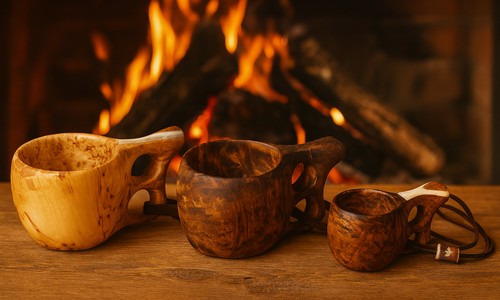
Unique and handcrafted Christmas gift ideas
And for Christmas, consider the gift wrapping option to delight your loved ones.
Would you like to learn more about kuksa and Finland?
If you're passionate about kuksa, these articles should also interest you.

Anne-Laure Compain
Maintenance
How to care for your kuksa?Discover ways to extend the life of your kuksa and the four mistakes to avoid.

Anne-Laure Compain

Alexis Le Baron

Anne-Laure Compain

Anne-Laure Compain

Anne-Laure Compain
For Christmas, try to win one of our 3 favorite kuksa. A handmade wooden mug to celebrate the festive season. 🎄
To enter, add your email address below
Contest results on December 21. 🍀
